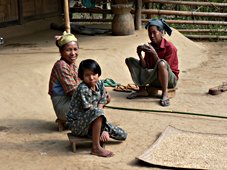Fieldwork
Tiwa
see corresponding research topic
Introduction
text and images by Philippe Ramirez
The Tiwa case is exemplary of the complex relationships between geographical settings, social structures, languages and ethnic identity in North-East India. This studies falls into a general questioning about the role of hills/plains interfaces in the anthroplogy and history of Northeast India (see our topic on the Hills and Plains in the Anthropology of Northeast India ).
The Tiwas, most of whom live in the Morigaon and Karbi-Anglong districts of Assam, have for a long time been referred to as “Lalung”. Some Assamese chronicles ( buranji ) tell of how some Lalung families living under the Jaintia State's authority (Eastern Meghalaya) were settled in the plains in XVIIth century. British and most post-Independence accounts provide a very confusing image of the Lalungs, mixing together people with very contrasted features. The situation today is that the Tiwa ethnic entity, i.e. people who call themselves Tiwa, are divided into two very distinct cultural and social divisions: in the plains they speak Assamese, follow a patrilineal descent system and bear Assamese patronyms; in the hills, they speak a Tibeto-Burmese language of the Bodo-Garo family, are mostly matrilineal and divided into clearly identified clans. They both also differ in their religious features, with a contrasted level of exposure to “Hinduism”, with Hill Tiwas being moreover partly converted to Christianity.

 HillTiwas and Plains Tiwas
HillTiwas and Plains Tiwas
Despite this striking cultural dichotomy, today Tiwas undoubtedly form an "ethnic group", with both hill and plain dwellers acknowledging a single identity. This does not exclude the possibility of mixed or “loose” ethnic identities, but there is definitely a core of people of all walks of lifewho claim they belong to an entity called “Tiwa”. Since the late 1970's several Tiwa organizations have been campaigning to promote their culture and to obtain specific political rights.
To explain the genesis of Tiwa distinctiveness raises a challenge. One of the leads I am exploring in this project is the common allegiance of most Tiwas to a series of rajas, particularly Gobha raja. Today these rajas only have a ritual role to play, but we know that their ancestors were entrusted with the task of safeguarding markets and trade routes which connected the plains, under the authority of the Ahom rulers, to the hills, under the Jaintia State. This suggests that "Tiwa" as a distinct entity may have something to do with (commercial, ritual, political...) exchanges and more broadly with their geographical position on the “margins” between two States, between two worlds.
 Kutusi Mokhodharam, an ancient market spot in Karbi-Anglong
Kutusi Mokhodharam, an ancient market spot in Karbi-Anglong
